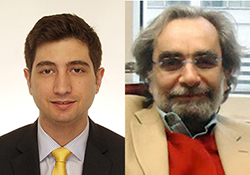
If you want to avoid chronic back pain, put out the cigarette. A new Northwestern Medicine study has found that smokers are three times more likely than nonsmokers to develop chronic back pain, and dropping the habit may cut your chances of developing this often debilitating condition.
“Smoking affects the brain,” said Bogdan Petre, lead author of the study and a technical scientist in Physiology. “We found that it affects the way the brain responds to back pain and seems to make individuals less resilient to an episode of pain.”
This is the first evidence to link smoking and chronic pain with the part of the brain associated with addiction and reward. The study was published online in the journal Human Brain Mapping.
The results come from a longitudinal observational study of 160 adults with new cases of back pain. At five different times throughout the course of a year they were given MRI brain scans and were asked to rate the intensity of their back pain and fill out a questionnaire which asked about smoking status and other health issues. Thirty-five healthy control participants and 32 participants with chronic back pain were similarly monitored.
Scientists analyzed MRI activity between two brain areas (nucleus accumbens and medial prefrontal cortex, NAc-mPFC), which are involved in addictive behavior, and motivated learning. This circuitry is critical in development of chronic pain, the scientists found.
These two regions of the brain “talk” to one another and scientists discovered that the strength of that connection helps determine who will become a chronic pain patient. By showing how a part of the brain involved in motivated learning allows tobacco addiction to interface with pain chronification, the findings hint at a potentially more general link between addiction and pain.
“That circuit was very strong and active in the brains of smokers,” Petre said. “But we saw a dramatic drop in this circuit’s activity in smokers who – of their own will – quit smoking during the study, so when they stopped smoking, their vulnerably to chronic pain also decreased.”
Medication, such as anti-inflammatory drugs, did help study participants manage pain, but it didn’t change the activity of the brain circuitry. In the future, behavioral interventions, such as smoking cessation programs, could be used to manipulate brain mechanisms as an effective strategy for chronic pain prevention and relief.
The National Institutes of Neurological Disorders and Stroke grant NS035115 funded this study.
Other Northwestern authors of the paper include senior author Apkar Apkarian, PhD, professor in Physiology, Anesthesiology and Physical Medicine and Rehabilitation; Souraya Torbey, MD; James Griffith, PhD, research assistant professor in Medical Social Sciences; Gildasio De Oliveira, MD, assistant professor in Anesthesiology and the Center for Healthcare Studies; Kristina Hermann; Ali Mansour, MD; Alex Baria, PhD, postdoctoral researcher, Marwan Baliki, research associate in Physiology; and Thomas Schnitzer, MD, PhD, professor in Physical Medicine and Rehabilitation and Medicine-Rheumatology.






